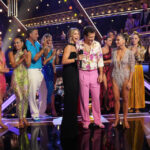Growing up with dreams of the American dance world while training in Moscow felt like chasing a distant star. For a competitive ballroom and jazz dancer like myself, the United States was the epicenter of jazz dance, a place I yearned to perform. However, from afar in Russia, our perceptions of the American dance scene were painted with certain stereotypes. After moving to the U.S. and joining the national tour of Pippin, I’ve discovered that the reality of pursuing dance here is a fascinating contrast to those preconceived notions about Dance In Russian and the American dance environment.
Expectation: American Dance – A Hyper-Competitive, Hardcore World
Reality painted a picture of relentless competition and an intensely hardcore atmosphere within the American dance community. Coming from the rigorous discipline ingrained in Russian dance training, I braced myself for an even more cutthroat environment.
Reality: Joy and Positivity in American Dance Culture
What I encountered was a refreshing surprise: the American dance community, from dancers to choreographers and teachers, exudes a genuine joy and enthusiasm for their craft. It seems deeply rooted in the American mentality – a conscious effort to find the positive in every experience. Hearing phrases like “have fun” and “enjoy every moment” exchanged among dancers before performances was initially unexpected. In Russian dance circles, while joy was present, the emphasis on overt expressions of enjoyment was less pronounced. This American approach is a beautiful perspective, fostering a more mindful appreciation for the present moment in dance.
Expectation: Diluting My “Russian” Style Onstage
I anticipated needing to shed my “Russian-ness” onstage, believing that my inherent style might not resonate or be valued in the American dance context.
Reality: Embracing My Russian Identity – A Unique Advantage
Instead, my Russian accent and inherent attitude became unexpected assets. American choreographers have actually encouraged me to “just be Russian,” valuing the confidence and pride associated with my cultural background. My Russian heritage became a tool to build a stronger stage presence. Playfully referencing Russian stereotypes – the strength and mysteriousness often attributed to us – has proven surprisingly beneficial in performance. It’s about harnessing a cultural perception as a performance enhancer.
Expectation: Ballet Mastery – A Prerequisite for Russian Dancers
Given the global reputation of Russian ballet, I naturally assumed a strong ballet technique would be an unspoken expectation, a baseline requirement for any dancer from Russia.
Reality: Jazz Dance Roots and Diverse Russian Dance
This expectation held some truth. The reputation of Russian ballet does precede us, often leading to assumptions of ballet proficiency. However, my personal strength lies in jazz dance. Discovering Luigi technique felt like a homecoming. Russia’s dance landscape is far broader than just ballet; we have robust schools dedicated to modern, contemporary, and ballroom dance. My journey highlights that “dance in Russian” encompasses a spectrum of styles, not solely classical ballet.
Expectation: Choreography – A Closed Door for Newcomers
Breaking into choreography seemed like a formidable challenge for a newcomer in the U.S. dance scene. Establishing oneself as a choreographer in a new country felt daunting.
Reality: Openness to New Talent and Diverse Dance Voices
Surprisingly, major American dance festivals welcomed my work, even without prior knowledge of my background. The American dance world, in my experience, is remarkably open to new talent. There’s a refreshing lack of prejudice; judgment is based on ability and artistic merit. My nationality, rather than a hindrance, has often been perceived as a unique and interesting element. This openness allows for diverse expressions of “dance in russian” to find their place.
Expectation: “So You Think You Can Dance” – The Pinnacle of American Dance
I had somewhat of a simplified view, imagining that mainstream American dance culture revolved primarily around shows like “So You Think You Can Dance,” perhaps overshadowing deeper historical connections.
Reality: Deep Roots in Dance History and Tradition
To my delight, American dance masters exhibit a profound connection to the history and traditions of dance, mirroring the respect for heritage I witnessed in Russia. Studying at the musical theater dance program at Jacob’s Pillow was eye-opening. The archives there are a treasure trove of past masterpieces. I felt a tangible link to the pioneers of American dance, like Ted Shawn and Jack Cole, their legacies vibrantly alive. This experience revealed a depth and historical awareness within American dance that resonated deeply with my understanding of “dance in russian” traditions.
Expectation: American Auditions – Intensely Stressful and Grueling
Auditions in the U.S. were anticipated to be incredibly intense, pushing dancers to their absolute limits in a high-pressure environment.
Reality: High Competition, but Focused Engagement
The audition process is indeed stressful, the level of competition undeniably high. The pace at which you need to absorb choreography is rapid. However, being a Russian dancer, often the only one in the room, inadvertently became a strategy. It allowed me to detach from pre-audition anxieties and focus intently on my strengths. This sense of being slightly separate yet fully engaged proved to be a unique advantage in navigating the competitive landscape of American dance auditions.


